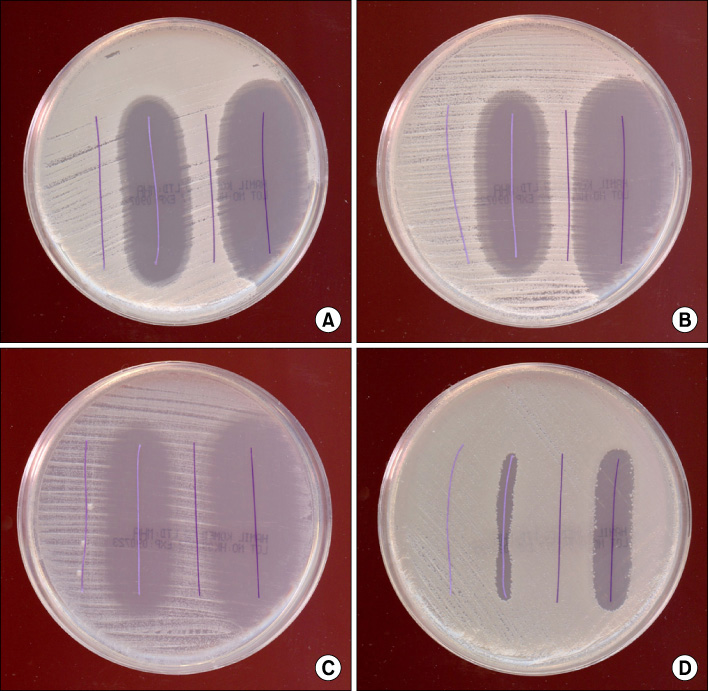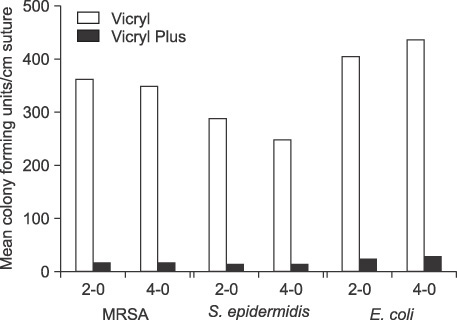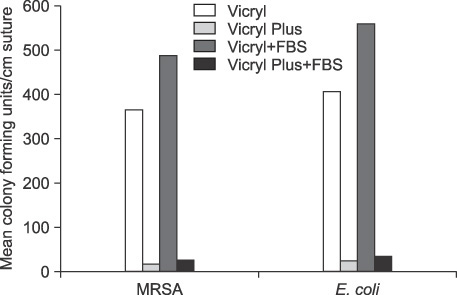J Korean Surg Soc.
2010 Jan;78(1):1-6. 10.4174/jkss.2010.78.1.1.
In Vitro Antibacterial Efficacy of Vicryl and PDS Plus Antibacterial Suture
- Affiliations
-
- 1Department of Surgery, Asan Medical Center, University of Ulsan College of Medicine, Seoul, Korea. jhyook@amc.seoul.kr
- 2Department of Laboratory Medicine, Asan Medical Center, University of Ulsan College of Medicine, Seoul, Korea.
- KMID: 1775438
- DOI: http://doi.org/10.4174/jkss.2010.78.1.1
Abstract
-
PURPOSE: Surgical site infection (SSI) is the most common nosocomial infection in surgical patients, and this accounts for approximately 17% of all hospital-acquired infections. Suture materials are possibly significant sources of SSI. This study aims to evaluate the in vitro antibacterial efficacy of Vicryl and PDS plus antibacterial suture coating with triclosan against bacteria.
METHODS
Vicryl and PDS plus antibacterial suture coating with and without triclosan were tested for in vitro efficacy against methicillin-susceptible Staphylococcus aureus, methicillin-resistant S. aureus, methicillin-resistant Staphylococcus epidermidis, Escherichia coli by a zone of inhibition assay and test of bacterial adhesion and viability.
RESULTS
Vicryl and PDS plus antibacterial suture coating with triclosan demonstrated activity against all tested bacteria in vitro. Evaluations by a zone of inhibition assay and test of bacterial adhesion and viability show the antibacterial activity compared with untreated sutures. Pretreatment of surgical sutures with fetal bovine serum did not diminish antibacterial activity of the triclosan-coated sutures compared with non-coated sutures (P<0.01).
CONCLUSION
Vicryl and PDS plus antibacterial suture reduced in vitro colonization of several strains of bacteria compared with untreated control sutures.
Keyword
MeSH Terms
Figure
Reference
-
1. Mangram AJ, Horan TC, Pearson ML, Silver LC, Jarvis WR. Hospital Infection Control Practices Advisory Committee. Guideline for prevention of surgical site infection, 1999. Infect Control Hosp Epidemiol. 1999. 20:250–280.2. Weaving P, Cox F, Milton S. Infection prevention and control in the operating theatre: reducing the risk of surgical site infections (SSIs). J Perioper Pract. 2008. 18:199–204.3. Vadaux P, Francois P, Lew DP, Waldvogel FA. Waldvogel FA, Bisno AL, editors. Host factors predisposing to and influencing therapy of foreign body infections. Infections Associated with Indwelling Medical Devices. 2000. 3rd ed. Washington, DC: ASM Press;1–26.4. Kaiser AB, Kernodle DS, Parker RA. Low-inoculum model of surgical wound infection. J Infect Dis. 1992. 166:393–399.5. Chuard C, Lucet JC, Rohner P, Herrmann M, Auckenthaler R, Waldvogel FA, et al. Resistance of Staphylococcus aureus recovered from infected foreign body in vivo to killing by antimicrobials. J Infect Dis. 1991. 163:1369–1373.6. Zimmerli W, Waldvogel FA, Vaudaux P, Nydegger UE. Pathogenesis of foreign body infection: description and characteristics of an animal model. J Infect Dis. 1982. 146:487–497.7. Christensen GD, Simpson WA, Bisno AL, Beachey EH. Experimental foreign body infections in mice challenged with slime-producing Staphylococcus epidermidis. Infect Immun. 1983. 40:407–410.8. Vaudaux P, Grau GE, Huggler E, Schumacher-Perdreau F, Fiedler F, Waldvogel FA, et al. Contribution of tumor necrosis factor to host defense against staphylococci in a guinea pig model of foreign body infections. J Infect Dis. 1992. 166:58–64.9. Zimmerli W. Experimental models in the investigation of device-related infections. J Antimicrob Chemother. 1993. 31:Suppl D. 97–102.10. Chu CC, Williams DF. Effects of physical configuration and chemical structure of suture materials on bacterial adhesion. A possible link to wound infection. Am J Surg. 1984. 147:197–204.11. Katz S, Izhar M, Mirelman D. Bacterial adherence to surgical sutures. A possible factor in suture induced infection. Ann Surg. 1981. 194:35–41.12. Anderson JM, Marchant RE. Waldvogel FA, Bisno AL, editors. Biomaterials: factors favoring colonization and infection. Infections Associated with Indwelling Medical Devices. 2000. 3rd ed. Washington, DC: ASM Press;89–110.13. Ming X, Rothenburger S, Yang D. In vitro antibacterial efficacy of MONOCRYL plus antibacterial suture (Poliglecaprone 25 with triclosan). Surg Infect (Larchmt). 2007. 8:201–208.14. Edmiston CE, Seabrook GR, Goheen MP, Krepel CJ, Johnson CP, Lewis BD, et al. Bacterial adherence to surgical sutures: can antibacterial-coated sutures reduce the risk of microbial contamination? J Am Coll Surg. 2006. 203:481–489.15. Ming X, Rothenburger S, Nichols MM. In vivo and in vitro antibacterial efficacy of PDS plus (polidioxanone with triclosan) suture. Surg Infect (Larchmt). 2008. 9:451–457.16. Esuvaranathan K, Kuan YF, Kumarasinghe G, Bassett DC, Rauff A. A study of 245 infected surgical wounds in Singapore. J Hosp Infect. 1992. 21:231–240.
- Full Text Links
- Actions
-
Cited
- CITED
-
- Close
- Share
- Similar articles
-
- A Study on The Antibacterial Effect of antibiotic Impregnated Bone Cement
- Influences of Suture Materials on Corneal Astigmatism After Cataract Surgery
- Effectiveness of Vicryl plus(R)(Ethicon, USA) in Nosocomial Bacteria
- Comparative Study of Subcutaneous Buried Suture Materials in Rabbits
- Antibacterial Efficacy of Dental Sealant Containing Phytoncide





